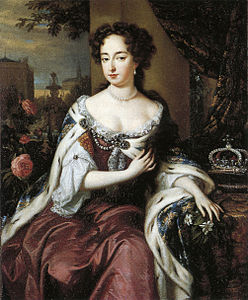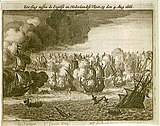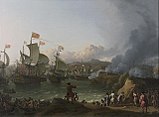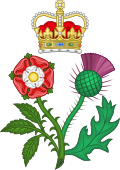Stuart period: Difference between revisions
→top: details |
→James VI and I: 1603-1625: detail, Ireland |
||
| Line 35: | Line 35: | ||
==Political History== |
==Political History== |
||
===James VI and I: 1603-1625=== |
===James VI and I: 1603-1625=== |
||
{{Main| Jacobean era|James VI and I}} |
|||
====Three kingdoms==== |
|||
James VI, king of Scotland, also became king of the entirely separate kingdom of England when Queen Elizabeth died. He also became king of Ireland, but the English were jus reestablishing lost control there. The English re-conquest was completed after victory in the [[Nine Years' War (Ireland)|Nine Years' War]], 1594–1603. James' appointees in Dublin as [[Lord Deputy of Ireland]] established real control over Ireland for the first time, bringing a centralised government to the entire island, and successfully disarmed the native lordships. The great majority remained Catholic, but James promoted heavy Protestant migration from Scotland into the Ulster region. The new arrivals were known as Scots-Irish or Scotch-Irish, and in turn many migrated to the new American colonies in the Stuart period.<ref>Tyler Blethen and Curtis Wood, eds., ''Ulster and North America: transatlantic perspectives on the Scotch-Irish'' (1997).</ref> |
|||
===Charles I: 1625-1649=== |
===Charles I: 1625-1649=== |
||
In 1625 Charles became the king of a land deeply involved in a European war and rent by escalating escalating religious controversies. Like his father, he believed in the divine right of kings to rule, and one was unable to work successfully with Parliament. By 1629 he had transformed the political landscape, dissolved parliament, and begun a period of eleven years of personal rule.<ref>Kevin Sharpe, ''The personal rule of Charles I'' (1992). </ref><ref> Lovell J. Reeve, ''Charles I and the road to personal rule'' (2003).</ref> |
In 1625 Charles became the king of a land deeply involved in a European war and rent by escalating escalating religious controversies. Like his father, he believed in the divine right of kings to rule, and one was unable to work successfully with Parliament. By 1629 he had transformed the political landscape, dissolved parliament, and begun a period of eleven years of personal rule.<ref>Kevin Sharpe, ''The personal rule of Charles I'' (1992). </ref><ref> Lovell J. Reeve, ''Charles I and the road to personal rule'' (2003).</ref> |
||
Revision as of 12:00, 22 August 2017
| Stuart period | |||
|---|---|---|---|
| 1603–1714 | |||
 King Charles I and the soldiers of the English Civil War as illustrated in An Island Story: A Child's History of England (1906) | |||
| Including | |||
| Monarch(s) | |||
| Leader(s) | |||
Chronology
| |||
| Periods in English history |
|---|
| Timeline |
The Stuart period of British history is 1603 to 1714, the rule of the House of Stuart. The period ended with the death of Queen Anne and the accession of George I from the German House of Hanover.
The period was plagued by internal and religious strife, and a large-scale civil war. Charles I was executed in 1649, The Interregnum (1649–1660), largely under the control of Oliver Cromwell, is included here for continuity, even though the Stuarts were in exile. The Cromwell regime collapsed and Charles II had very wide support for his taking the throne in 1660. His brother James II was overthrown in 1689 because he was Catholic. He was replaced by his Protestant daughter Mary and her Dutch husband William III. Mary's sister Anne was the last of the line. For the next half century James II and his son James Francis Edward Stuart and grandson Charles Edward Stuart claimed they were the true Stuart kings, but they were in exile and attempts to return with French help were defeated.
Political History
James VI and I: 1603-1625
Three kingdoms
James VI, king of Scotland, also became king of the entirely separate kingdom of England when Queen Elizabeth died. He also became king of Ireland, but the English were jus reestablishing lost control there. The English re-conquest was completed after victory in the Nine Years' War, 1594–1603. James' appointees in Dublin as Lord Deputy of Ireland established real control over Ireland for the first time, bringing a centralised government to the entire island, and successfully disarmed the native lordships. The great majority remained Catholic, but James promoted heavy Protestant migration from Scotland into the Ulster region. The new arrivals were known as Scots-Irish or Scotch-Irish, and in turn many migrated to the new American colonies in the Stuart period.[1]
Charles I: 1625-1649
In 1625 Charles became the king of a land deeply involved in a European war and rent by escalating escalating religious controversies. Like his father, he believed in the divine right of kings to rule, and one was unable to work successfully with Parliament. By 1629 he had transformed the political landscape, dissolved parliament, and begun a period of eleven years of personal rule.[2][3]
Personal Rule: 1629-1640
The greatest challenge in ruling without a Parliament was raising money. Charles first ended the war and cut the budget, then discovered a series of ingenious methods to raise money. They been rarely used, but were nevertheless legal. They were exceedingly unpopular. Across the line of legality when he began to levy "ship money" and forced the payment by interior towns. Protests escalated.[4][5]
The Long Parliament elected 1640
Civil War and Interregnum: 1642-1660
The First Civil War 1642-45 ended in victory for the Parliamentarians. The Second Civil War was fought in 1648; Charles lost and was executed in 1649.
The monarchy was temporarily displaced by the Commonwealth of England, 1649 to 1660. Oliver Cromwell ruled directly from 1653 to 1658.
Oliver Cromwell: 1653-58
After Cromwell's death in 1658 his the Commonwealth fell apart. The Convention Parliament welcomed Charles II, son of Charles I, to return from exile and become king.
Restoration: Charles II and James II: 1660-1688
William and Mary: 1689-1702
Anne: 1702-1714
Social history
Population
The total population of England grew steadily in the 17th century, from 1600 to about 1660, then declined slightly and stagnated between 1649 and 1714. The population was about 4.2 million and 1603, 5.2 million in 1649, 5.1 million in 1660, 4.9 million in 1688, and 5.3 million in 1714.[6][7]
Education
Historians have looked at local documents to see how many men and women used their signature and how many used X’s. Literacy rates were very low before 1500, but grew steadily in the next three centuries, with men twice as likely to be literate as comparable women. In 1500, literacy rates for women were 1%; by 1560 they had reached 5%; by 1640 about 10%; by 1710 about 25% (versus 50% for men). Two forces were at work: Protestant religion called for the ability to read the Bible, and changing social and economic conditions. For example towns grew rapidly, providing jobs in retailing in which literacy was a distinct advantage.[8][9] There was no free schooling for ordinary children, but in the towns and cities small local private schools were opened for the benefit of the boys of the middle classes, and a few were opened for girls. The rich and of the nobility relied on private tutors. Private schools were starting to open for young men of the upper classes, and universities operated in Scotland and England. Oxford and Cambridge, however, provided some education for prospective Anglican ministers, but otherwise had academic standards well below Scotland.[10][11]
Stuart foreign policy
Stuart England was primarily consumed with internal affairs. King James I (reigned 1603–25) was sincerely devoted to peace, not just for his three kingdoms of England, Scotland and Ireland, but for Europe as a whole.[12] He disliked Puritans and Jesuits alike, because of their eagerness for warfare. He called himself "Rex Pacificus" ("King of peace.")[13] Europe was deeply polarized, and on the verge of the massive Thirty Years' War (1618–1648), with the smaller established Protestant states facing the aggression of the larger Catholic empires. On assuming the throne, James made peace with Catholic Spain, and made it his policy to marry his son to the Spanish Infanta (princess) in the "Spanish Match". The marriage of James' daughter Princess Elizabeth to Frederick V, Elector Palatine on 14 February 1613 was more than the social event of the era; the couple's union had important political and military implications. Across Europe, the German princes were banding together in the Union of German Protestant Princes, headquartered in Heidelberg, the capital of the Palatine. King James calculated that his daughter's marriage would give him diplomatic leverage among the Protestants. He thus planned to have a foot in both camps and be able to broker peaceful settlements. In his naïveté, he did not realize that both sides were playing him as a tool for their own goal of achieving the destruction of the other side. Spain's ambassador Count Gondomar knew how to manipulate the king. The Catholics in Spain, as well as the Emperor Ferdinand II, the Vienna-based leader of the Habsburgs and head of the Holy Roman Empire, were both heavily influenced by the Catholic Counter-Reformation. They had the goal of expelling Protestantism from their domains.[14]
Lord Buckingham (1592–1628), who increasingly was the actual ruler of Britain, wanted an alliance with Spain.[15] Buckingham took Charles with him to Spain to woo the Infanta in 1623. However, Spain's terms were that James must drop Britain’s anti-Catholic intolerance or no marriage. Buckingham and Charles were humiliated and Buckingham became the leader of the widespread British demand for a war against Spain. Meanwhile, the Protestant princes looked to Britain, since it was the strongest of all the Protestant countries, to give military support for their cause. James' son-in-law and daughter became king and queen of Bohemia, which outraged Vienna. The Thirty Years’ War began, as the Habsburg Emperor ousted the new king and queen of Bohemia, and massacred their followers. Catholic Bavaria then invaded the Electoral Palatinate, and James's son-in-law begged for James's military intervention. James finally realized that his policies had backfired and refused these pleas. He successfully kept Britain out of the European-wide war that proved so heavily devastating for three decades. James's backup plan was to marry his son Charles to a French Catholic princess, who would bring a handsome dowry. Parliament and the British people were strongly opposed to any Catholic marriage, were demanding immediate war with Spain, and strongly favored the Protestant cause in Europe. James had alienated both elite and popular opinion in Britain, and Parliament was cutting back its financing. Historians credit James for pulling back from a major war at the last minute, and keeping Britain in peace.[16]
Frederick's election as King of Bohemia in 1619 deepened the Thirty Years' War--a conflagration that destroyed millions of lives in central Europe, but only barely touched Britain. The intense hatred and rivalry of Catholic versus Protestant princes was the main cause, King James' determination to avoid involvement in the continental conflict, even during the "war fever" of 1623, was one of the most significant, and most positive, aspects of his reign.[17]
During 1600–1650 the kings made repeated efforts to colonize Guiana in South America. They all failed and the lands (Suriname) were ceded to the Dutch in 1667.[18][19]
Anglo-Dutch Wars
The Anglo-Dutch Wars were a series of three wars which took place between the English and the Dutch from 1652 to 1674. The causes included political disputes and increasing competition from merchant shipping. Religion was not a factor, since both sides were Protestant.[20] The British in the First Anglo-Dutch War (1652–54) had the naval advantage with larger numbers of more powerful "ships of the line" which were well suited to the naval tactics of the era. The British also captured numerous Dutch merchant ships. In the Second Anglo-Dutch War (1665–67) Dutch naval victories followed. This second war cost London ten times more than it had planned on, and the king sued for peace in 1667 with the Treaty of Breda. It ended the fights over "mercantilism" (that is, the use of force to protect and expand national trade, industry, and shipping.) Meanwhile, the French were building up fleets that threatened both the Netherlands and Great Britain. In the Third Anglo-Dutch War (1672–74), the British counted on a new alliance with France but the outnumbered Dutch outsailed both of them, and King Charles II ran short of money and political support. The Dutch gained domination of sea trading routes until 1713. The British gained the thriving colony of New Netherland, which was renamed as the Province of New York.[21][22]
Glorious Revolution of 1688
Historians have long regarded the overthrow of King James II in 1688 as a decisive break in English history, especially as it made the Parliament of England supreme over the King. Steven Pincus argues that this revolution was the first modern revolution; it was violent, popular, and divisive. He rejects older theories to the effect that it was an aristocratic coup or a Dutch invasion. Instead, Pincus argues it was a widely supported and decisive rejection of James II. The people could not tolerate James any longer. He was too close to the French throne; he was too Roman Catholic; and they distrusted his absolutist modernisation of the state. What they got instead was the vision of William of Orange, shared by most leading Englishmen, that emphasized consent of all the elites, religious toleration of all Protestant sects, free debate in Parliament and aggressive promotion of commerce. Pincus sees a dramatic transformation that reshaped religion, political economy, foreign policy and even the nature of the English state.[23][24]
Timeline
The Stuart period began in 1603 with the death of Queen Elizabeth I and the accession of King James I. It ended in 1714 (after 111 years) with the death of Queen Anne and the accession of King George I, the first king of the House of Hanover.
Monarchs
The House of Stuart produced six monarchs who ruled during this period.
-
Charles II
(1660–1685) -
James II
(1685–1688) -
Mary II
(1689–1694) -
William III
(1689–1702) -
Anne
(1702–1714)
Historical gallery
References
- ^ Tyler Blethen and Curtis Wood, eds., Ulster and North America: transatlantic perspectives on the Scotch-Irish (1997).
- ^ Kevin Sharpe, The personal rule of Charles I (1992).
- ^ Lovell J. Reeve, Charles I and the road to personal rule (2003).
- ^ Davies, Early Stuarts, pp 82–85, 216–8.
- ^ M. D. Gordon, "The Collection of Ship-money in the Reign of Charles I." Transactions of the Royal Historical Society 4 (1910): 141-162. online
- ^ E.A. Wrigley and R.S. Schofield, The population history of England 1541–1871 (1981) p 528
- ^ J.A. Sharpe, Early modern England: a social history 1550–1760 (1997) pp 36–42.
- ^ Jackie Eales, "To booke and pen: Women, education and literacy in Tudor and Stuart England." Historian 119 (2013): 24:24–29.
- ^ Dorothy Gardiner, English Girlhood at School: A Study of Women's Education through twelve centuries (1929)
- ^ John Lawson; Harold Silver (2013). A Social History of Education in England. Routledge. pp. 116, 154–55.
- ^ Alexander Broadie, ed. The Scottish Enlightenment (1999) pp 10–14
- ^ Roger Lockyer, James VI and I (1998) pp 138–58.
- ^ Malcolm Smuts, "The making of Rex Pacificus: James VI and I and the Problem of Peace in an Age of Religious War," in Daniel Fischlin and Mark Fortier, eds., Royal Subjects: Essays on the Writings of James VI and I (2002) pp 371–87
- ^ W. B. Patterson, "King James I and the Protestant cause in the crisis of 1618–22." Studies in Church History 18 (1982): 319–334.
- ^ Godfrey Davies, The Early Stuarts: 1603–1660 (1959), pp 47–67
- ^ Jonathan Scott, England's Troubles: 17th-century English Political Instability in European Context (Cambridge UP, 2000), pp 98–101
- ^ G.M.D. Howat, Stuart and Cromwellian Foreign Policy (1974) pp 17–42.
- ^ Joyce Lorimer, "The failure of the English Guiana ventures 1595–1667 and James I's foreign policy." Journal of Imperial and Commonwealth History 21#.1 (1993): 1–30.
- ^ Albert J. Loomie, Spain & the Early Stuarts, 1585–1655 (1996).
- ^ Steven C. A. Pincus, Protestantism and Patriotism: Ideologies and the Making of English Foreign Policy, 1650–1668 (1996)
- ^ James Rees Jones, The Anglo-Dutch wars of the seventeenth century (1996) online
- ^ Gijs Rommelse, "The role of mercantilism in Anglo‐Dutch political relations, 1650–74." Economic History Review 63#3 (2010): 591–611.
- ^ Steven Pincus, 1688: The First Modern Revolution (2011)
- ^ Steven C. A. Pincus, England's Glorious Revolution 1688–1689: A Brief History with Documents (2005)
Further reading
- Bucholz, Robert, and Newton Key. Early modern England 1485-1714: A narrative history (2009); textbook.
- Campbell, Mildred. English yeoman under Elizabeth and the early Stuarts (1942), rich coverage of rural life
- Clark, George Norman. The Later Stuarts, 1660–1714 (Oxford History of England) (1956), standard scholarly survey
- Coward, Barry, and Peter Gaunt. The Stuart Age: England, 1603–1714 (5th ed 2017) new introduction
- Coward, Barry, ed. A Companion to Stuart Britain (2009) excerpt and text search; 24 advanced essays by scholars
- Davies, Godfrey. The Early Stuarts, 1603–1660 (Oxford History of England) (2nd ed. 1959)
- Fritze, Ronald H. and William B. Robison, eds. Historical Dictionary of Stuart England, 1603–1689 (1996), 630pp; 300 short essays by experts emphasis on politics, religion, and historiography excerpt
- Kenyon, J.P. Stuart England (Penguin, 1985), survey
- Kishlansky, Mark A. A Monarchy Transformed: Britain, 1603–1714 (Penguin History of Britain) (1997), standard scholarly survey; excerpt and text search
- Kishlansky, Mark A. and John Morrill. "Charles I (1600–1649)", Oxford Dictionary of National Biography (2004; online edn, Oct 2008) accessed 22 Aug 2017 doi:10.1093/ref:odnb/5143
- Lipson, Ephraim. The economic history of England: vol 2: The Age of Mercantilism (7th ed. 1964)
- Miller, John. The Stuarts (2004)
- Miller, John. The restoration and the England of Charles II (2014).
- Morrill, John. Stuart Britain: A Very Short Introduction (2005) excerpt and text search; 100pp
- Morrill, John, ed. The Oxford illustrated history of Tudor & Stuart Britain (1996) online
- Murray, Catriona. Imaging Stuart Family Politics: Dynastic Crisis and Continuity (Routledge, 2017).
- Notestein, Wallace. English people on the eve of colonization, 1603–1630 (1954). scholarly study of occupations and roles
- Ogg, David. England in the Reign of Charles II (2 vol 1934).
- Ogg, David. England in the Reigns of James II and William III (1955).
- Pincus, Steve. 1688: The First Modern Revolution (2011)
- Pincus, Steven C. A. England's Glorious Revolution 1688–1689: A Brief History with Documents (2005)
- Roberts, Clayton and F. David Roberts. A History of England, Volume 1: Prehistory to 1714 (2nd ed. 2013), textbook.
- Sharp, David. The Coming of the Civil War 1603-49 (2000), textbook
- Sharp, David. England in Crisis 1640-60 (2000), textbook
- Sharp, David. Oliver Cromwell (2003); textbook
- Sharpe, Kevin. The personal rule of Charles I (Yale UP, 1992).
- Sharpe, Kevin, and Peter Lake, eds. Culture and politics in early Stuart England (1993)
- Traill, H. D. and J.S. Mann, eds. Social England; a record of the progress of the people in religion, laws, learning, arts, industry, commerce, science, literature and manners, from the earliest times to the present day (1903) short essays by experts; illustrated' 946pp. online
- Woolrych, Austin. Britain in Revolution: 1625–1660 (2004).
- Wroughton, John. ed. The Routledge Companion to the Stuart Age, 1603–1714 (2006) excerpt and text search
Historiography
- Baxter, Steven B. "The Later Stuart's: 1660–1714," in Richard Schlatter, ed., Recent Views on British History: Essays on Historical Writing since 1966 (Rutgers UP, 1984), pp 141 – 166
- Braddick, Michael J., ed. The Oxford Handbook of the English Revolution (Oxford UP, 2015).
- Burgess, Glenn. "On revisionism: an analysis of early Stuart historiography in the 1970s and 1980s." Historical Journal (1990) 33#3 pp: 609–627.
- Elton, G.R. Modern Historians on British History 1485–1945: A Critical Bibliography 1945–1969 (1969), annotated guide to 1000 history books on every major topic, plus book reviews and major scholarly articles. online
- Richardson, R. C. The Debate on the English Revolution Revisited (1977)
- Underdown, David. "New Ways and Old and Early Stuart History," in Richard Schlatter, ed., Recent Views on British History: Essays on Historical Writing since 1966 (Rutgers UP, 1984), pp 99–140
- Zagora, Perez. "English History, 1558–1640: A Bibliographical Survey," in Elizabeth Chapin Furber, ed. Changing views on British history: essays on historical writing since 1939 (Harvard University Press, 1966), pp 119–40
Primary sources
- Blitzer, Charles, ed. The Commonwealth Of England: Documents Of The English Civil Wars, The Commonwealth And Protectorate, 1641-1660 (2012).
- Browning, A. ed. English Historical Documents 1660–1714 (1953)
- Coward, Barry, and Peter Gaunt, eds. English Historical Documents, 1603–1660 (2011)
- Key, Newton, and Robert O. Bucholz, eds. Sources and debates in English history, 1485-1714 (2009).
- Kenyon, J.P. ed. The Stuart Constitution, 1603-1688: Documents and Commentary (1986).
- Stater, Victor, ed. The Political History of Tudor and Stuart England: A Sourcebook (Routledge, 2002) online
- People of the Stuart period
- House of Stuart
- Stuart England
- Stuart Scotland
- Kingdom of Scotland
- English monarchy
- Scottish monarchy
- 17th century in England
- 17th century in Scotland
- 1700s in England
- 1710s in England
- 18th century in Scotland
- 1700s in Scotland
- 1710s in Scotland
- 1603 establishments in England
- 1603 establishments in Scotland
- 1714 disestablishments in Great Britain











